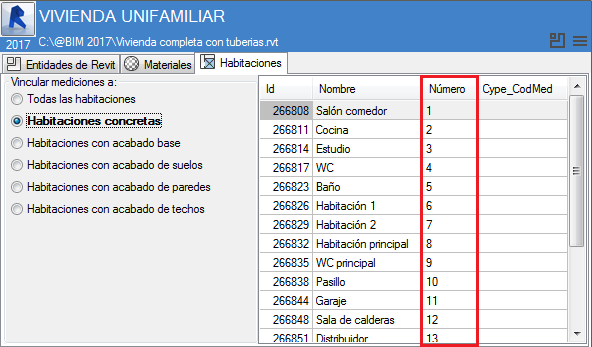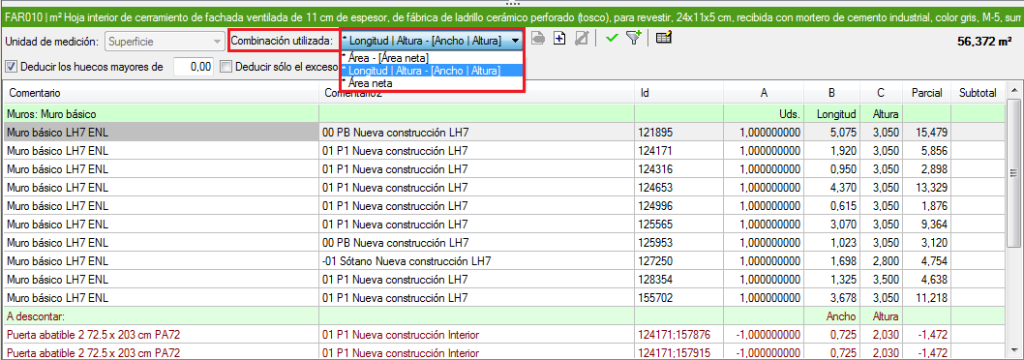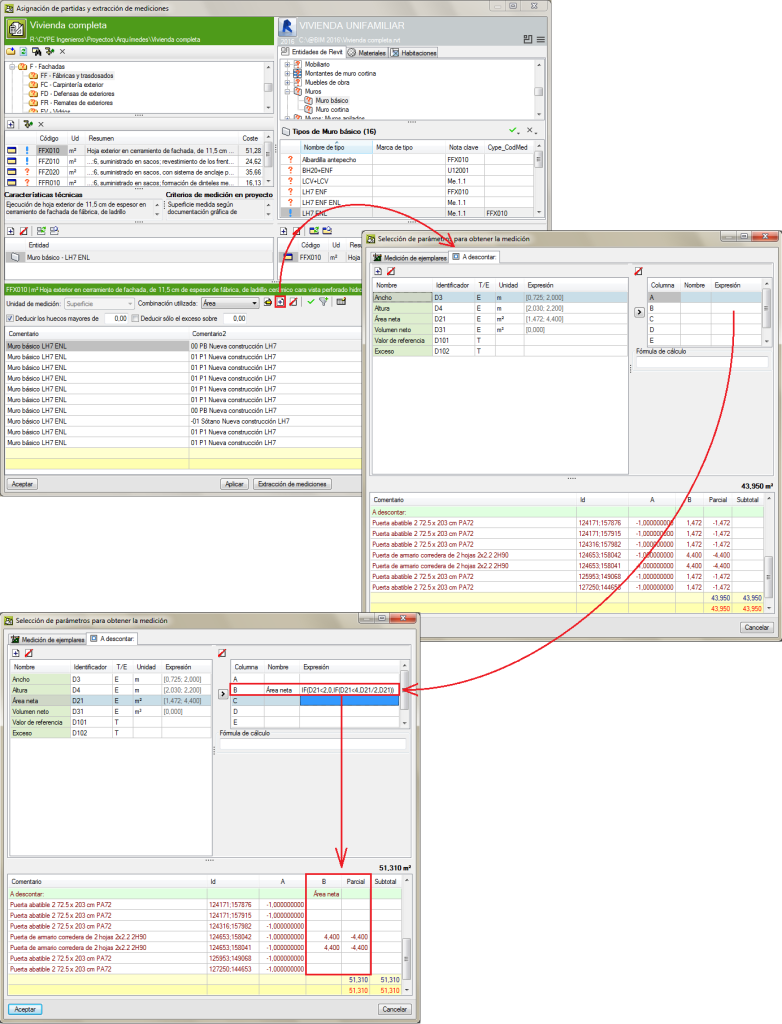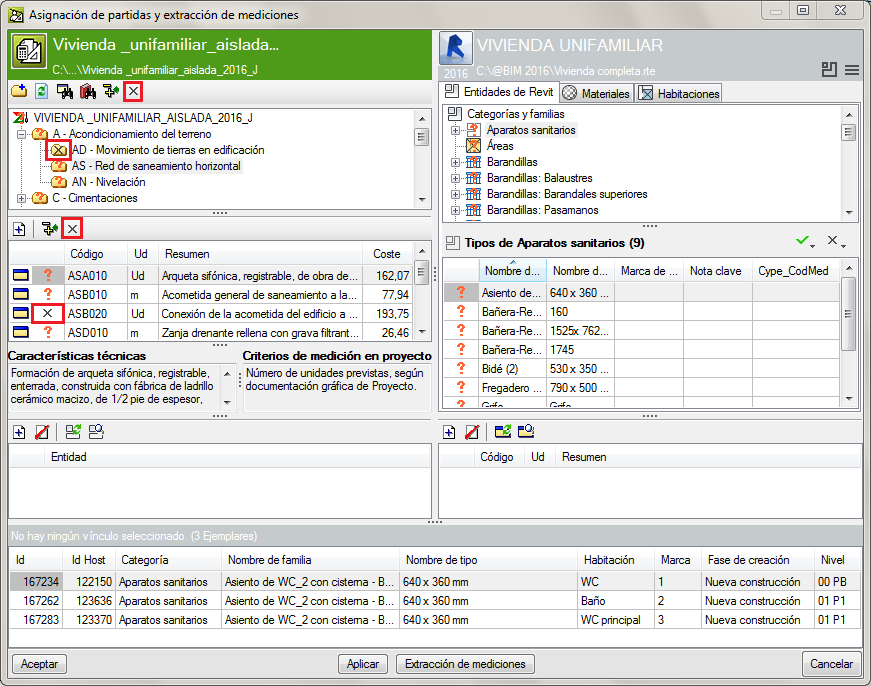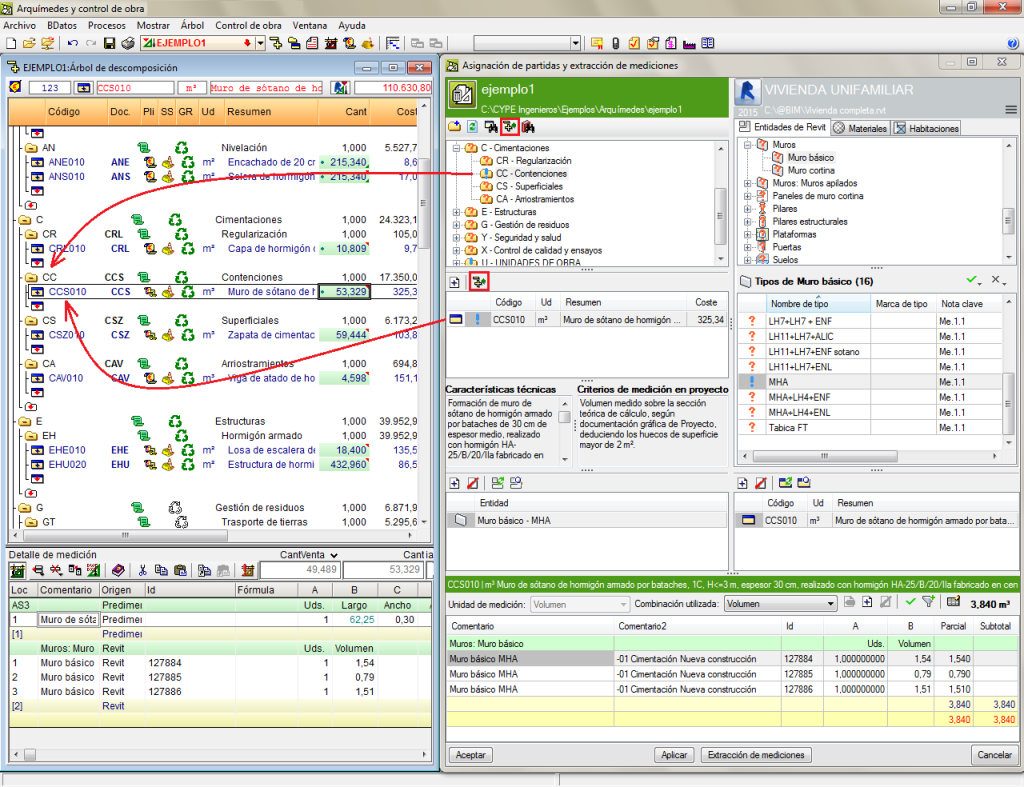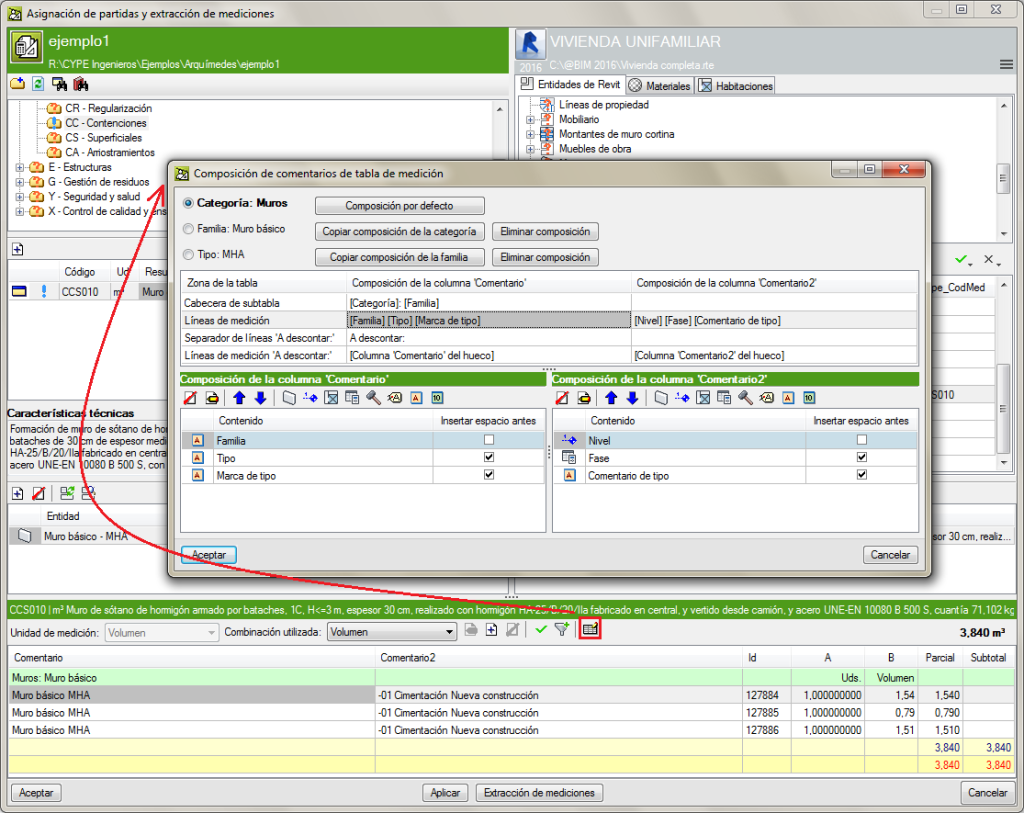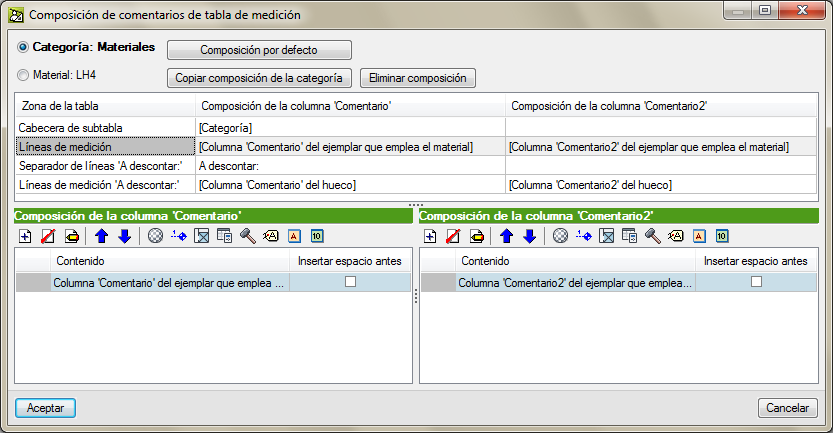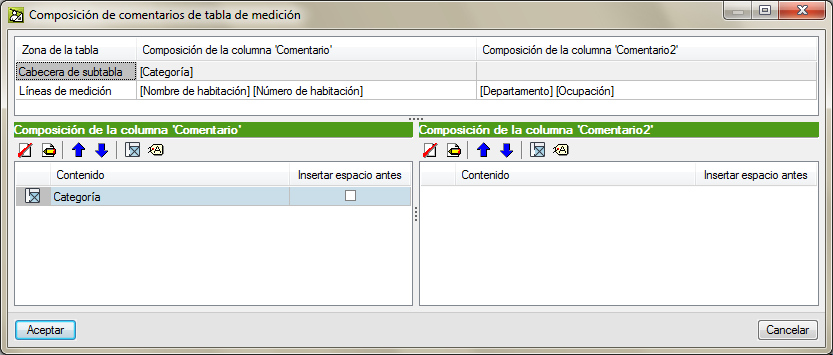The order of filters defined in quantities to restrict elements is memorised. This order is available by accessing the filter editing option.
Update history
Arquimedes
Filter order memorisation in quantities
- Published on
- 2017.b
“Number” column in the “Job item assignment and quantity extraction” dialogue box
- Published on
- 2017.b
Part to deduct from quantities
- Published on
- 2017.b
Organise decomposition of job items by nature
The dialogue “Organise decomposition of job items by nature” (Tree > Reconstruct tree > Organise decomposition of job items by nature > Accept button) has been implemented, which allows users to arrange the decomposition lines of all the job units. In this dialogue, users can change the order of the nature of the decomposition (materials, machinery, labour...). The concepts of each nature will always be arranged in alphabetical order.
The order in which they appear in the new dialogue each time it is opened is always that established in the “Classification by nature” dialogue box (Show > Concept classification > Classification by nature) regardless of whether it has been changed previously. Whilst the new dialogue box is not accepted (Organise decomposition of job items by nature), the order of the decomposition will not vary.
The order will not affect the decomposition of the job units that have partial payments.
Please bear in mind, that due to the arrangement, job units which contain percentage-type concepts (auxiliary resources, complementary direct expenses...) could vary in price because these concepts affect all or some of the concepts situated above them and never those situated below.
- Published on
- 2017.b
Unit concept classification table
The Unit concept classification tables allow for all the unit concepts to be classified using unified indices. Currently, the unit concept price indices used in Mexico have been introduced. In upcoming program versions, unit concept price indices of other countries will be introduced and the polynomial formula for those countries will be obtained.
The Unit concept classification table provides the Price adjustment indices to be able to create the polynomial formula to check or adjust prices in those countries where polynomial formulas are not pre-established by the code.
The option to create Unit concept classification tables is located in Show > Concept classification > Unit concept classification tables.
- Published on
- 2017.a
Classification of unit concepts by nature
Up to the 2016.n version of Arquimedes, the unit concepts could be classified depending on their type or nature: “Material”, “Labour”, “Machinery” and “Unclassified”.
As of the 2017.a version, the “Material”, “Labour”, “Machinery” and “Unclassified” unit concepts can be classified in other classes or subclasses. This way unit prices can be identified to be classified by different Nature and Class levels. For example, materials or machinery can be classified as they are defined in the table shown below:
The option to be able to carry out this classification is located in the menu: Show > Concept classification > Classification by nature.
- Published on
- 2017.a
Import quantities from “Revit® 2017”
As of the 2016.m version, the “Bill of quantities of Revit models” module of Arquimedes allows for the program to connect with the new “Revit® 2017” version.
- Published on
- 2016.m
Quantities to deduct
The procedure to generate a table with quantities to deduct from an extracted Revit model has been improved.
A new tab: “To deduct”, has been included in the Selection of parameters to obtain quantities dialogue box (which can be accessed by selecting the ![]() button in the “Job item assignment and quantity extraction” window. This tab only appears when openings have been defined and have to be deducted from the job in Revit. The parameters to be applied in the creation of the table with the quantities to be subtracted can be defined here. It is possible to include rules to establish the quantity to be deducted using logical expressions.
button in the “Job item assignment and quantity extraction” window. This tab only appears when openings have been defined and have to be deducted from the job in Revit. The parameters to be applied in the creation of the table with the quantities to be subtracted can be defined here. It is possible to include rules to establish the quantity to be deducted using logical expressions.
This way more precise values are obtained for quantities, by for example, taking into account quantities to subtract due to openings.
An example that can be resolved using this improvement is the subtraction of openings following more than one rule. E.g.: openings greater than 4 m2 could be subtracted in façade and partition quantities and, if the area of the opening lies between 2 and 4 m2, only half is to be deducted.
- Published on
- 2016.l
Mark chapters or job items that are not to be measured
In order to aid users to identify chapters and job items that are not going to be measured using the Revit model, the button has been added in the chapter and job item zones of the Job item assignment and quantity extraction dialogue box.
To mark chapters or job items which are not to be measured, the button corresponding to chapters or job items must be pressed. In no case does the mark prevent or block the program from carrying out the measurement. Upon pressing the button, the mark to not measure can be added or removed.
- Published on
- 2016.j
Show chapter or job item in the “Decomposition tree” window
A new button Show in the “Decomposition tree” window  has been added in the Job item assignment and quantity extraction dialogue box (which appears when a Revit job is linked to Arquimedes). This button displays the chapter or job item that has been selected from the chapter or job item zone of the “Job item assignment and quantity extraction” dialogue box, whilst the position of the current column is maintained in the Decomposition tree window.
has been added in the Job item assignment and quantity extraction dialogue box (which appears when a Revit job is linked to Arquimedes). This button displays the chapter or job item that has been selected from the chapter or job item zone of the “Job item assignment and quantity extraction” dialogue box, whilst the position of the current column is maintained in the Decomposition tree window.
As an example, using this option, users can obtain a parallel view of the status of the (already consolidated) quantities contained in the Decomposition tree window and those to be extracted in the “Job assignment and quantity extraction” dialogue box.
- Published on
- 2016.j
Comments composition for the quantities table
The Comments composition for the quantities table dialogue box, which appears when the Comments button ![]() is pressed, has been improved. Users have more comment construction possibilities for Subtable headers, Quantity lines, Line spacers “To deduct” and Quantity lines “To deduct”. The composition of the Comment and Comment2 columns can be seen in a single dialogue box, allowing users to compare both comments at the same time.
is pressed, has been improved. Users have more comment construction possibilities for Subtable headers, Quantity lines, Line spacers “To deduct” and Quantity lines “To deduct”. The composition of the Comment and Comment2 columns can be seen in a single dialogue box, allowing users to compare both comments at the same time.
Default compositions are created using information of the Category, Family or Type of the quantity elements, which aids in composing the comments.
When quantities are extracted, if comments have been defined using the Category, Family and Type information (or any combination of them), the comments that have been created using the more detailed information prevail. The priority is Type > Family > Category. In other words, the program checks to see if there are any comments in Type and if so, these comments are used. If none are found, the program checks if there are comments present in Family, otherwise it checks if there are comments in Category.
If the quantities of the job item are obtained by linking them to a Material, as of the 2016.j version, comments can be composed by using information of the Material category or of the material itself.
If job items are assigned from the Rooms tab, the creation of the comments is simplified.
- Published on
- 2016.j
New menu options
A new option, Close all has been added to the “File” menu, which closes all the databases that open at once.
Another option Close other views has also been added in the “Window” menu, which allows users to close all the views of the active database, except the current view.
- Published on
- 2016.i


